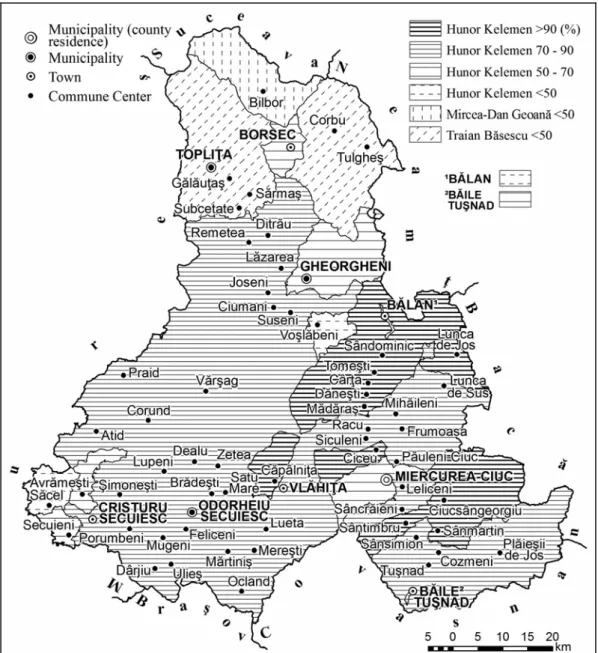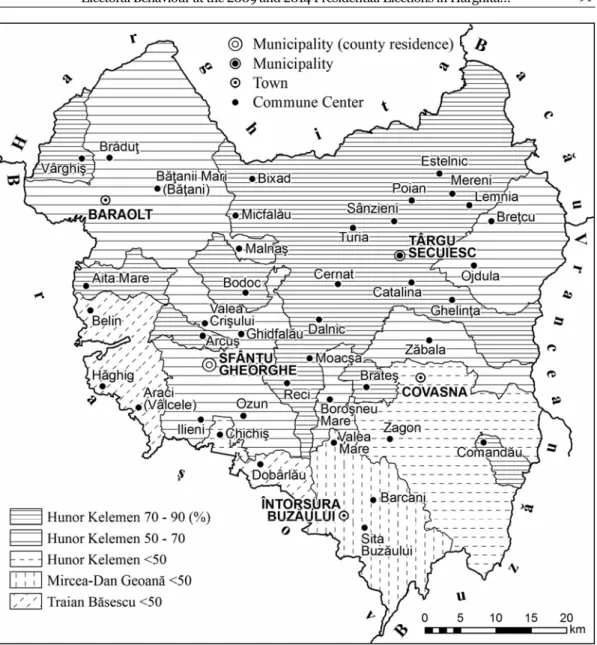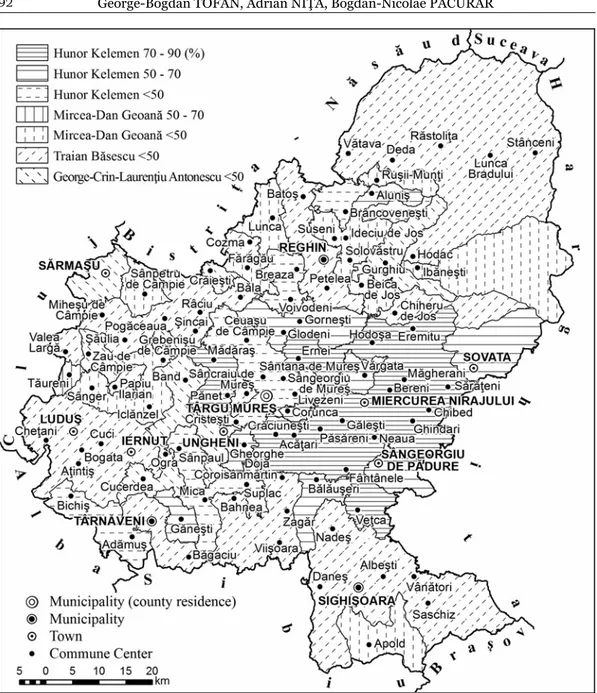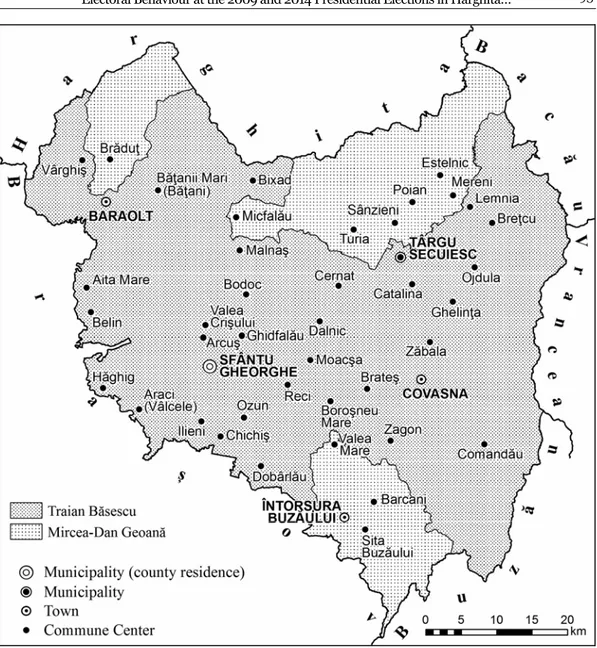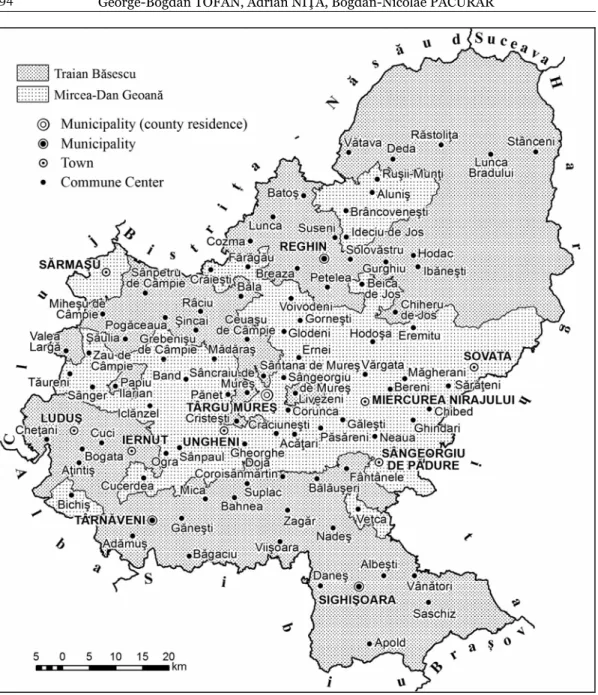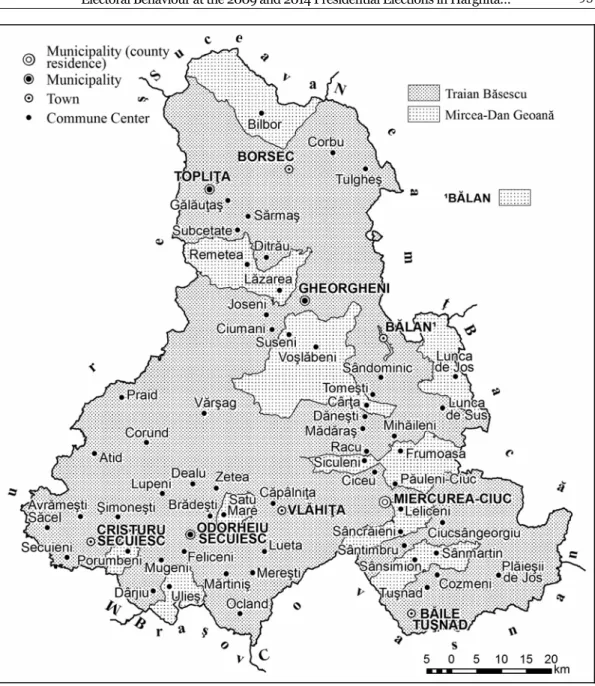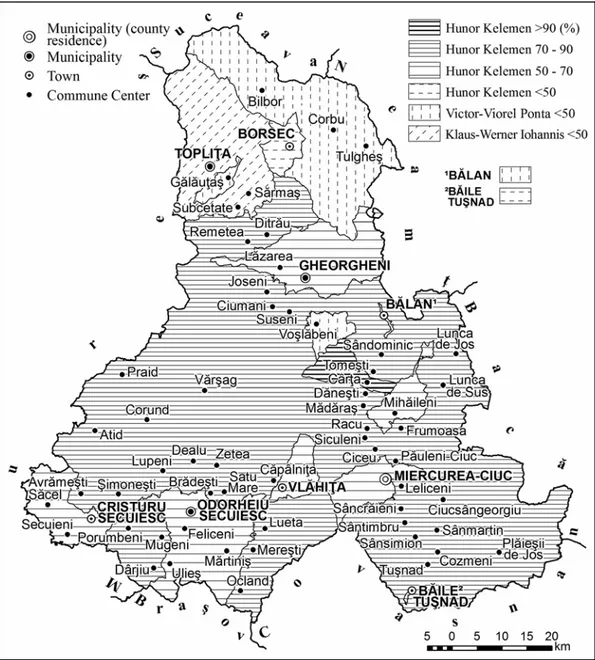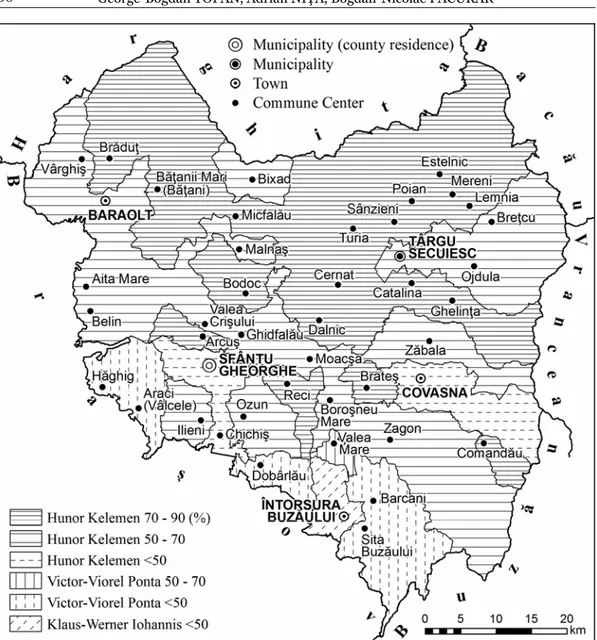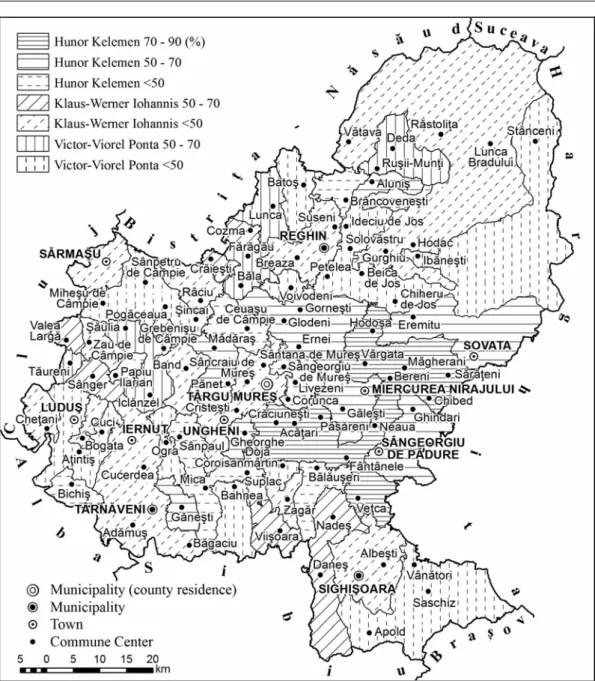A
AnnaalleelleeUUnniivveerrssiitt iii iddiinn OOrraaddeeaa, ,SSeerriia aGGeeooggrraaffiiee Year XXXXV, no. V 11//2200115 (June), pp. 5 8888--110044
ISSN 11222211--11227733, E-ISSN 22006655--3344009 Article 9 no. 225511111100--667755
http://istgeorelint.uoradea.ro/Reviste/Anale/anale.htm
ELECTORAL BEHAVIOUR AT THE 2009 AND 2014 PRESIDENTIAL
ELECTIONS IN HARGHITA, COVASNA AND MURE
Ş
COUNTIES
George-Bogdan TOFAN
„Vasile Goldiş” Western University of Arad, Faculty of Natural Sciences, Engineering and Informatics, Departament of Biology, Ecology and Geography, Baia Mare Branch, 5 Culturii Street, Romania,
e-mail: tofanbogdan_geografie@yahoo.com
Adrian-Florin NI
„Babeş-Bolyai” University, Faculty of Geography, Gheorgheni Branch, Romania, e-mail: nitaadrian@hotmail.com
Bogdan-Nicolae P CURAR
Centre for Research on Settlements and Urbanism, Faculty of Geography, Babe -Bolyai University Cluj-Napoca; Cluj County Council, Urbanism and Territorial Planning Department, Cluj-Napoca,
e-mail: pacurarbogdan@ymail.com
Abstract: This study represents a synthesis of the electoral behaviour exhibited by the population of Harghita, Covasna and Mureş counties, at the 2009 presidential elections, held on 22nd November (first tour) and 6th December (second tour), and at the presidential elections of 2014 (first tour, 2nd November, and second tour, 16th November). In terms of candidates, the following occured: in 2009, first tour, with 12 candidates, from which only
Traian Băsescu and Mircea Geoană proceeded to the second round, and 14 candidates in the first round of the 2014 elections (10 of them from political parties and alliances). The second round was defined by the first two candidates with the highest number of votes, which were
Victor-Viorel Ponta and Klaus-Werner Iohannis.
Key words: the President of Romania, polling stations, void votes, turnout.
* * * * * *
INTRODUCTION
Research on electoral geography and especially on the geography of presidential elections emerged in the 1990s, the first studies being conducted by Pop, 1992, 1997, 2001, 2006, 2010; Ilieş, 1998; Creţan, 1999, 2006; Bodocan, 2001; Boamfă, 2011; Iaţu, 2013 and Giugăl, 2013, which proposed several research models in this new field, located between science and politics, an interesting, dynamic, and almost inexhaustible area of study.
The first author of the endeavour (G. B. Tofan) is at his third study regarding the electoral behaviour of the inhabitants of Harghita, Covasna and Mureş counties (Tofan, 2013; Tofan & Timariu, 2013). The results of the presidential elections will come to light after the analysis, synthesis and intepretation of the statistical data provided by the Central Electoral Bureau of
Electoral Behaviour at the 2009 and 2014 Presidential Elections in Harghita… 89
Romania and by the Permanent Electoral Authority. The three analysed counties, each one an electoral district (no. 15-Covasna; no. 21- Harghita and no. 28-Mureş), encompass 10 cities, 15 towns and 189 communes.
THE ELECTORAL BEHAVIOUR AT THE 2009 PRESIDENTIAL ELECTIONS At the presidential elections of 2009, there were two electoral rounds, as follows:
-for the first round (22nd November 2009), 12 representatives from a large political spectre formally applied for the mandate of President of Romania: Constantin-Ninel Potîrcă, Independent Candidate, George-Crin-Laurențiu Antonescu, National Liberal Party, George Becali, New Generation Party - Christian Democratic, Kelemen Hunor, Democratic Union of Hungarians in Romania, Corneliu Vadim-Tudor, Greater Romania Party, Mircea-Dan Geoană, Social Democratic Party-Conservative Party, Traian Băsescu, Liberal Democratic Party, Ovidiu-Cristian Iane, Romanian Ecologist Party, Sorin-Mircea Oprescu, Independent Candidate, Remus-Florinel Cernea, Green Party, Constantin Rotaru, Socialist Alternative Party and Gheorghe-Eduard Manole, Independent Candidate.
The total number of votes in the three counties mentioned above was 429 154. Most votes were attributed to the following candidates: Kelemen Hunor, 43.63% (187 277 votes), who won in the counties with a Hungarian majority, that is Harghita (71.24%, 83 199 votes) and Covasna (52.79%, 40 386 votes), followed by Băsescu Traian, 22.06% (94 713 votes), who obtained the highest number of votes in Mure County (64 752 votes, 27.45%,), Geoană Mircea-Dan, 13.48% (57 873 votes), third place in Harghita and Mure counties, and fourth place in Covasna County,
Antonescu George-Crin-Laurențiu, 12.06% (51 796 votes), third place in Covasna County, and fourth in Harghita and Mure counties, and Vadim-Tudor Corneliu, 4.33% (18 620 votes), fifth place in all three counties, according to the valid votes.
The following seven candidates, in terms of votes won, were: Oprescu Sorin-Mircea
(1.26%, 5 442 votes), Becali George (1.26%, 5 422 votes), Cernea Florinel Remus (0.63%, 2 706 votes), Rotaru Constantin (0.45%, 1 933 votes), Potîrcă Constantin-Ninel (0.38%, 1 639 votes),
Manole Gheorghe-Eduard (0.20%, 864 votes) and Iane Ovidiu-Cristian (0.18%, 809 votes). The candidate of the Democratic Union of Hungarians in Romania, Kelemen Hunor, won the highest number of votes in 139 polling stations (65.42%, from a total of 214 localities), most being situated in Harghita County (60), with percentages of over 90% in settlements like Căpâlnița, Cârța, Ciceu, Ciucsângeorgiu, Dăne ti, Lunca de Jos, Mădăraş, Sândominic, Sânmartin, Sântimbru and Tome ti, followed by Mure County (42), with percentages of over 80% in Acățari, Bereni, Chibed, Hodo a, Neaua i Păsăreni, and then in Covasna (37), with percentages exceeding 70% in Arcu , Bixad, Bodoc, Brate , Catalina, Cernat, Comandău, Dalnic, Estelnic, Ghelința, Lemnia, Mereni, Micfalău, Moac a, Poian, Reci, Sânzieni, Turia and Vârghi .
Traian Băsescu, the Liberal Democratic Party's representative, came second in Harghita (12.70%, 14 836 votes) and Covasna counties (19.77%, 15 125 votes), but defeated Kelemen Hunor in Mure County, with a total score of 27.45%.
At station level (cities, towns and communes), Băsescu Traian won the most votes in 48 stations (22.42% of a total of 214 localities), 38 in Mure County, with more than 40% in Sighi oara, Ludu , Băgaciu, Bato , Chețani, Cozma and Dane (the last registering the highest percentage, 58.60%), Hodac, Mihe u de Câmpie, Nade , Pogăceaua, Răstolița, Râciu, ăulia, Vii oara and Zagăr, then in six polling stations located in Harghita, with more than 35% (Sărma , Corbu, Subcetate, Gălăuța , Toplița), but only 29.55% in Tulghe , while in the County of Covasna, Traian Băsescu won the highest number of votes in four polling stations in Belin (46.05%), Vâlcele (41.50%), Dobârlău (40.90%) and Hăghig (37.52%).
George-Bogdan TOFAN, Adrian NIŢĂ, Bogdan-Nicolae PĂCURAR
90
Figure 1. The distribution of votes per main candidates during the first round of the 2009 presidential elections, Harghita County
(Data source: Central Election Bureau of Romania, author: G. B. Tofan)
Electoral Behaviour at the 2009 and 2014 Presidential Elections in Harghita… 91
Figure 2. The distribution of votes per main candidates during the first round of the 2009 presidential elections, Covasna County
(Data source: Central Election Bureau of Romania, author: G. B. Tofan)
The fourth candidate, if we take into consideration the number of votes won, was George-Crin-Laurențiu Antonescu, with a percentage of 12.06% (51 796) of the people's votes, his best position (third place) being in Covasna (9.89%, 7 573 votes), but only fourth place in Mure (16.05%, 37 867 votes) and Harghita (5.44%, 6 356 votes) counties. At regional level, he won in eight stations, all in Mure County (Crăie ti, 47.60%, Zau de Câmpie, 42.26%, Ungheni, 35.69%, Band, 35.33%, Cucerdea, 32.45%, Gurghiu, 28.67%, Sărma u, 36.87% and Ogra, 27.14%.
George-Bogdan TOFAN, Adrian NIŢĂ, Bogdan-Nicolae PĂCURAR
92
Figure 3. The distribution of votes per main candidates during the first round of the 2009 presidential elections, Mureş County
(Data source: Central Election Bureau of Romania, author: G. B. Tofan)
Electoral Behaviour at the 2009 and 2014 Presidential Elections in Harghita… 93
Figure 4. Vote distribution in Covasna County, during the second round of the 2009 presidential elections (Data source: Central Election Bureau of Romania, author: G. B. Tofan)
In terms of void votes, their percentages were between 1.44% and 2.16%, with higher values in Mure and Covasna.
In urban areas, Traian Băsescu won 52.38% of the votes (114 710), that is 28.23% of the votes from the entire region. Meanwhile, Mircea-Dan Geoană managed a score of 52.35% of the urban vote, or 24.14% of his votes from the region.
George-Bogdan TOFAN, Adrian NIŢĂ, Bogdan-Nicolae PĂCURAR
94
Figure 5. Vote distribution in Mureş County, during the second round of the 2009 presidential elections (Data source: Central Election Bureau, author: G. B. Tofan)
Mircea Geoană won the majority in seven small towns (Întorsura Buzăului, 51.07%, Bălan, 58.61%, Miercurea Nirajului, 57.43%, Sângeorgiu de Pădure, 62.36%, Sărma u, 51.80%, Sovata, 51.47% and Ungheni, 51.35%), and in Târgu Mure (55.06%).
The victory of Traian Băsescu was defined by different values at county level, that is 51.20% in Mure , 56.43% in Harghita, but 59.78% in Covasna.
Electoral Behaviour at the 2009 and 2014 Presidential Elections in Harghita… 95
Figure 6. Vote distribution in Harghita County, during the second round of the 2009 presidential elections (Data source: Central Election Bureau, author: G. B. Tofan)
Mircea Geoană won 41 910 votes (43.57%), out of which 18 366 in urban areas (43.82%), with a majority only in Bălan (1 289 votes, 58.61%), and 23 544 votes in rural areas (56.18%), especially in Bilbor, where a majority of votes was attained.
George-Bogdan TOFAN, Adrian NIŢĂ, Bogdan-Nicolae PĂCURAR
96
In the County of Mure , out of 241 719 votes, Traian Băsescu was first with 51.20% (123 764 votes), the rest of 48.80% (117 955) being won by Mircea Geoană.
Out of the 102 polling stations, 56 (54.90%) were won by Traian Băsescu, while 46 (45.10%) by Mircea Geoană.
If we take a look at the urban-rural situation, Mircea Geoană clearly won in cities and towns (55.18%, 65 095 votes, meaning 29.93% of his votes at county level, while Băsescu had 54.72%, 67 732 votes), which represents 28.08% of his votes at county level, but at rural level the situation changed, with Băsescu at 45.28%, and Geoană at 44.82%.
ELECTORAL BEHAVIOUR AT THE 2014 PRESIDENTIAL ELECTIONS
According to the Government's Decision no. 502/2014, the 2014 elections for the President of Romania were set on Sunday, 2nd November 2014. In line with the Constitution of Romania, Article 83, the presidency mandate is set at five years, with a single possibility for reelection.
In the first round of the 2014 presidential elections, 14 candidates joined the fight, 10 being proposed by political parties or alliances. Thus, the candidates were as follows (in the order of their registration): Victor-Viorel Ponta, the Social Democratic Party-the National Union for Romania-Conservative Parties Electoral Alliance; Klaus-Werner Iohannis, the Christian Liberal Alliance; Honor Kelemen, Democratic Union of Hungarians in Romania; Elena-Gabriela Udrea, the Popular Movement Party; William-Gabriel Brînză, the Romanian Ecologist Party; Constantin Rotaru, the Socialist Alternative Party; Corneliu Vadim-Tudor, Greater Romanian Party; Cristian-Dan Diaconescu, the People's - Dan Diaconescu Party; Zsolt Szilágy, the Hungarian People's Party of Transylvania, and Mirel-Mircea Amariţei, PRODEMO Party, plus a host of independent candidates (Monica-Luisa Macovei, Călin-Constantin-Anton Popescu Tăriceanu, Gheorghe Funar
and Teodor-Viorel Meleşcanu), candidatures backed by at least 200 000 people.
If we take into consideration all three counties, the total number of people registered on the permanent electoral lists was 937 202 electors (270 282 in Harghita, 184267 in Covasna and 482 653 in Mureş), out of which 429 369 electors turned out to vote, that is 45.81% (Covasna, 79 469, 43.12%; Harghita, 119 120, 44.07%; Mureş, 230 780, 47.81%).
The total number of votes was 418 423 (76 912 in Covasna, 116521 in Harghita and 224 990 in Mureş), the final tally for the first round of elections being: Hunor Kelemen, 163 808 votes (39.15%), Klaus-Werner Iohannis, 96 102 (22.97%), Victor-Viorel Ponta, 79 611 (19.02%), Zsolt Szilágy, 26 068 (6.23%), Elena-Gabriela Udrea, 11 969 (2.86%).
The remaining 40 865 votes (9.76%) went to the following candidates: Cristian-Dan Diaconescu, 8 693 (2.07%); Călin-Constantin-Anton Popescu-Tăriceanu, 8 443 (2.01%), Monica-Luisa Macovei, 8 022 (1.91%), Corneliu Vadim-Tudor, 7 828 (1.87%), Gheorghe Funar, 3 363 (0.80%),
Teodor-Viorel Meleşcanu, 1 957 (0.46%), William-Gabriel Brînză, 1 161 (0.27%), Constantin Rotaru, 1 128 (0.26%) and Mirel-Mircea Amariţei, 270 (0.06%).
At county level, Hunor Kelemen claimed first place in Harghita (62.96%) and in Covasna (50.41%), and third place in Mureş (22.96%).
At city, town and commune level, the representative of the Democratic Union of Hungarians in Romania won in 133 stations (62.15%), 58 in Harghita, with percentages of over 90% solely in his native commune, Cârţa (90.47%), followed by: Atid, Ciceu, Dăneşti, Joseni, Ocland, Racu, Remetea, Sâncrăieni, Tuşnad, Zetea etc., with percentages between 70-90%, while the percentages in urban centres were between 50-70%, for example Miercurea Ciuc, Gheorgheni, Odorheiu Secuiesc, Cristuru Secuiesc, Vlăhiţa, and below 50% in Băile Tuşnad, 46.80% and Borsec, 34.55%).
In Covasna County, Hunor Kelemen won a majority of votes in 38 stations, with very high percentages in rural areas, between 70-90% (Arcuş, Băţani, Catalina, Cernat, Dalnic, Lemnia, Poian, Turia, etc), but lower values in urban areas - between 50-70%, in Târgu Secuiesc, 57.65% and Baraolt, 56.19%, and below 50%, in Sfântu Gheorghe, 43.19% and Covasna, 35.54%.
Electoral Behaviour at the 2009 and 2014 Presidential Elections in Harghita… 97
Fântânele, Hodoşa, Neaua, Veţca, etc) and two urban settlements (Sângeorgiu de Pădure, 54.11% and Sovata, 58.61%).
Figure 7. Vote distribution per main candidates during the first round of the 2014 presidential elections, Harghita County
(Data source: Central Election Bureau, author: G. B. Tofan)
George-Bogdan TOFAN, Adrian NIŢĂ, Bogdan-Nicolae PĂCURAR
98
Figure 8. Vote distribution per main candidates during the first round of the 2014 presidential elections, Covasna County
(Data source: Central Election Bureau, author: G. B. Tofan)
In the County of Covasna, the Liberal Alliance came second (14.96%), with a majority of votes only in Întorsura Buzăului (39.11%), and third in Harghita (10.76%), with a majority below 50%, only in three Romanian settlements, located in the northern part of Giurgeu Depression (Sărmaş, 35.52%, Topliţa, 37.25% and Subcetate, 39.07%).
Electoral Behaviour at the 2009 and 2014 Presidential Elections in Harghita… 99
Figure 9. Vote distribution per main candidates during the first round of the 2014 presidential elections, Mureş County
(Data source: Central Election Bureau, author: G. B. Tofan)
George-Bogdan TOFAN, Adrian NIŢĂ, Bogdan-Nicolae PĂCURAR
100
the three counties in question, we have a reversal of the national situation: Klaus-Werner Iohannis, 96 102 votes (22.96%) and Victor-Viorel Ponta, 79 611 votes (19.02%).
In terms of the entire region, the total number of voters was 936 961 out of which 270 220 in Harghita, 184 212 in Covasna and 482 529 in Mureş, the turnout being 53.50% (501 285 voters), higher than the first round (45.81%).
In the second round, the population of these three counties voted heavily with Klaus-Werner Iohannis, 362 723 votes, (73.22%), with a clear victory in every urban area, while Victor-Viorel Ponta won 132 649 votes (26.78%), gaining majorities in some rural areas (Bilbor, Valea Mare, Vâlcele, Deda, Fărăgău, Miheşu de Câmpie, Ruşi Munţi, Şăulia, Sânpaul and Tăureni).
In Harghita, vote turnout was 47.83%, higher than the one registered during the first round (44.07%), but lower than the national average. Out of a total of 127 961 valid votes, 102 092 people (79.79%) voted for Klaus Iohannis, even if in some Romanian settlements, such as Bălan, Corbu, Gălăuţaş, Tulgheş, Voşlăbeni, people voted for Victor Ponta during the first round. The only polling station consistent in their vote was Bilbor (50.43%).
The County of Covasna registered a higher turnout during the second round (49.85%), compared to 43.12% in the first round, but at national level it had, alongside Harghita, one of the lowest turnouts.
Significant votes for Iohannis, as he obtained out of the 90 710 votes a 77.96% percentage (70 713) compared to 22.04% (19 997) for Ponta. Out of the six rural settlements (Barcani, Dobârlău, Hăghig, Sita Buzăului, Vâlcele, Valea Mare), who voted for Ponta during the first round, only the last two remained „loyal" during the second round of elections.
The same phenomenon took place in Mureş, with a 58.06% turnout (compared to 47.81% during the first round). Out of the 276 701 valid votes, 189 918 votes (68.64%) went to Iohannis, encompassing all urban areas, while Ponta obtained 86 783 votes (31.36%), won only in rural areas (Deda, Fărăgău, Miheşu de Câmpie, Ruşii Munţi, Şăulia, Sânpaul and Tăureni).
CONCLUSIONS
If we compare the electoral behaviour at the 2009 and the 2014 presidential elections regarding the number of votes and their territorial distribution, several aspects come to light:
- at both elections, the first round was clearly won by Kelemen Hunor, who came first in Harghita as well as in Covasna according to the number of valid votes (71.24% and 52.79% in 2009 and 62.96% in Harghita and 50.41% in Covasna in 2014);
- another important aspect is the one concerning the high number of polling stations where Kelemen Hunor won the majority (139 locations in 2009 and 133 in 2014, with percentages of over 90% in Ciuc Depression);
- in the counties of Harghita and Covasna, the social democratic and liberal democratic candidates won the most votes solely in settlements with a Romanian majority (Bilbor, Corbu, Tulgheş, Topliţa, Gălăuţaş, Sărmaş, Subcetate, Valea Mare, Barcani, Întorsura Buzăului, Sita Buzăului);
- in Mureş, ever since the first round of elections, first place was claimed by a Romanian candidate (Traian Băsescu, 27.45% and Klaus-Werner Iohannis, 32.02%);
- in 2009, during the first round of elections, the left wing candidate, Geoană Mircea-Dan, came third in Mureş and Harghita, and fourth in Covasna; the situation somewhat repeated itself in 2014, when Victor-Viorel Ponta came second in Mureş, third in Covasna and fourth in Harghita;
Electoral Behaviour at the 2009 and 2014 Presidential Elections in Harghita… 101
Figure 10. Vote distribution in Harghita County during the second round of the 2014 presidential elections (Data source: Central Election Bureau, author: G. B. Tofan)
- in terms of the votes obtained by the first two candidates during the first round of the 2014 presidential elections, in all three counties, there was a reversal of the situation at national level, meaning: Klaus Iohannis - 22.96% while Victor Ponta only 19.02%;
George-Bogdan TOFAN, Adrian NIŢĂ, Bogdan-Nicolae PĂCURAR
102
Electoral Behaviour at the 2009 and 2014 Presidential Elections in Harghita… 103
Figure 12. Vote distribution in Mureş County during the second round of the 2014 presidential elections (Data source: Central Election Bureau, author: G. B. Tofan)
REFERENCES
Boamfă I. (2011), Orientation of the Voters in the Presidential Election in Romania 1990-2009, Forum geografic. Studii şi cercetări de geografie şi protecţia mediului, vol. 10, Issue 2, Craiova.
Bodocan V. (2001), Etnie, confesiune şi comportament electoral în Transilvania. Studiu geografic, Editura Presa Universitară Clujeană, Cluj-Napoca.
Creţan R. (1999), Etnie, confesiune şi comportament electoral în Banat (Sfârşitul sec. al XIX şi sec. al XX-lea). Studiu geografic, Tipar Universitatea de Vest, Timişoara.
George-Bogdan TOFAN, Adrian NIŢĂ, Bogdan-Nicolae PĂCURAR
104
revăzutăşi adăugită, Editura Universităţii de Vest, Timişoara.
Giugăl A. (2013), Geografia electorală a Dobrogei: 1992-2012, Editura Fundaţiei pentru Studii Europene, Cluj-Napoca. Iaţu C. (coord) (2013), Atlasul electoral al României (1990-2009), Editura Universităţii „Alexandru Ioan Cuza”, Iaşi. Ilieş A. (1998), Etnie, confesiune şi comportament electoral în Crişana şi Maramureş (Sfârşitul sec. XIX şi sec. XX). Studiu
geografic, Editura Dacia, Cluj-Napoca.
Pop P.Gr. (1992), Romania. An Electoral Geography (September-October, 1992), Studia UBB, Geographia, Anul XXXVII, 1-2, Cluj-Napoca.
Pop P.Gr. (1997), România. Geografie Electorală (Noiembrie, 1996), Studia UBB, Geographia, Anul XLII, 1-2, Cluj-Napoca.
Pop P.Gr. (2001), România. Geografie electorală (noiembrie-decembrie 2000), Revista Română de Geografie Politică, Anul III, nr. 1, Edit. Universităţii din Oradea, Oradea.
Pop P.Gr. (2006), România. Geografie electorală (noiembrie-decembrie, 2004), Studia UBB, Geographia, Anul LI, 1, Cluj-Napoca.
Pop P.Gr. (2010), Presidential Elections in Romania. First Round (November 22) and Second Round (December 6), Studia UBB, Geographia, 2, Anul LV, 2010, p. 147-160, 14 p.
Tofan G.B. (2013), Mayor Election in Harghita County, Romania, June 2012, Revista Română de Geografie Politică, Year XV, no. 1, Editura Universităţii din Oradea, Oradea.
Tofan G.B., Timariu Cristina (2013), Parlamentary Election in Harghita, Covasna and Mureş Counties (9 th December 2012), Revista Română de Geografie Politică, Year XV, no. 2, Editura Universităţii din Oradea, Oradea.
http://www.bec2009p.ro/rezultate.html, consulted at 18. 02. 2015. http://www.bec2014.ro/rezultate/, consulted at 18. 02. 2015. http://www.roaep.ro/ consulted at 18. 02. 2015.
Submitted: Revised: Accepted and published online
